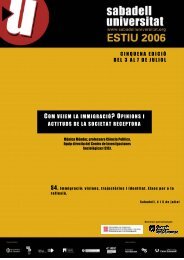From Party to Movement? The German Radical Right
From Party to Movement? The German Radical Right
From Party to Movement? The German Radical Right
You also want an ePaper? Increase the reach of your titles
YUMPU automatically turns print PDFs into web optimized ePapers that Google loves.
Minkenberg “<strong>From</strong> <strong>Party</strong> <strong>to</strong> <strong>Movement</strong>?<strong>The</strong> <strong>German</strong> <strong>Radical</strong> <strong>Right</strong> in Transition” 1<br />
<strong>From</strong> <strong>Party</strong> <strong>to</strong> <strong>Movement</strong>? <strong>The</strong> <strong>German</strong> <strong>Radical</strong> <strong>Right</strong> in Transition<br />
Michael Minkenberg<br />
Europa-Universität Viadrina Frankfurt (Oder)<br />
1. Introduction<br />
In international comparisons, the <strong>German</strong> radical right <strong>to</strong>day seems a rather marginal force.<br />
Neither does any of the right-wing radical parties hold seats in the Bundestag, European<br />
Parliament or, with few and temporary exceptions, in the state parliaments. Nor is there a<br />
charismatic leader like Jean-Marie Le Pen or Jörg Haider who keeps providing a continuous<br />
national focus of attention and feeding the public discourse with his ideas. Instead, the<br />
development of the radical right in <strong>German</strong>y fourteen years after unification is characterized by a<br />
general fragmentation along with clear-cut differences between old and new Länder. More<br />
precisely, it undergoes a decline of the party spectrum along with a consolidation in movement<br />
sec<strong>to</strong>r and subcultural milieus, particularly in the East. This article traces these changes since the<br />
“high” of elec<strong>to</strong>ral support and party development in the early 1990s and discusses the question<br />
<strong>to</strong> what extent differences in opportunity structures and cultural legacies between East and West<br />
contribute <strong>to</strong> these developments.<br />
2. <strong>The</strong> <strong>Radical</strong> <strong>Right</strong> in Perspective: Conceptualizing Ideological and Organizational<br />
Variants<br />
For a workable definition of right-wing radicalism in comparative perspective, it seems preferable <strong>to</strong><br />
avoid the shopping list quality of most definitions and tie it <strong>to</strong> theoretical concepts of social change<br />
which underlie most analyses of the radical right. 1 Most “classical” but also modern approaches (i.e.<br />
1 See discussion in Cas Mudde, <strong>The</strong> Ideology of the Extreme <strong>Right</strong> (Manchester: Manchester University Press,<br />
2000); for the following see also Michael Minkenberg, “<strong>The</strong> West European <strong>Radical</strong> <strong>Right</strong> as a Collective<br />
Ac<strong>to</strong>r: Modeling the Impact of Cultural and Structural Variables on <strong>Party</strong> Formation and <strong>Movement</strong><br />
S4. EXTREMA DRETA A EUROPA, UNA REALITAT POLIÈDRICA<br />
Sabadell, 5 i 6 de juliol de 2004
Minkenberg “<strong>From</strong> <strong>Party</strong> <strong>to</strong> <strong>Movement</strong>?<strong>The</strong> <strong>German</strong> <strong>Radical</strong> <strong>Right</strong> in Transition” 2<br />
the works by W. Kornhauser, S.M. Lipset, Lipset/Raab, Scheuch/Klingemann, up until the 1960s,<br />
H.G. Betz, P. Ignazi, H. Kitschelt and others from the 1990s on) include – implicitly or explicitly –<br />
arguments derived from modernization theory and they persuasively indicate conditions for a<br />
successful mobilization of right-wing radicalism. But they tell rather little about the relationship<br />
between rapid social change and the appeal of particular variants of radical right-wing ideology and<br />
organizational forms.<br />
It seems useful <strong>to</strong> build on modernization theory not just in terms of the societal context for<br />
mobilization but also in order <strong>to</strong> identify the core ideology of the phenomenon, not in the least<br />
because these theories might provide some conceptually grounded criteria for such analyses which<br />
help overcome the shopping list problem. 2 This is not the place, however, <strong>to</strong> review the vast amount<br />
of literature on modernization theory. Generally, modernization can be unders<strong>to</strong>od as a growing<br />
au<strong>to</strong>nomy of the individual (status mobility and role flexibility) and an ongoing functional<br />
differentiation of the society (segmentation and growing au<strong>to</strong>nomy of societal subsystems) 3 . In this<br />
light, right-wing radicalism can be defined as the radical effort <strong>to</strong> undo such social change. <strong>The</strong><br />
counter-concept <strong>to</strong> social differentiation is the nationally defined community, the counter-concept <strong>to</strong><br />
individualization is the return <strong>to</strong> traditional roles and status of the individual in such a community. It<br />
is this overemphasis on, or radicalization of, images of social homogeneity which characterizes<br />
radical right-wing thinking. <strong>The</strong> his<strong>to</strong>rical origins of right-wing radicalism are seen <strong>to</strong> lie in the<br />
interdependence of nation building, democratization, industrialization, and the growing importance<br />
of the natural sciences.<br />
Hence, right-wing radicalism will be defined primarily by the ideological criteria of populist<br />
and romantic ultranationalism, a myth of a homogenous nation which puts the nation before the<br />
individual and his/her civil rights and which therefore is directed against liberal and pluralist<br />
democracy (though not necessarily in favor of a fascist state), its underlying values of freedom and<br />
equality and the related categories of individualism and universalism. This definition focuses<br />
explicitly on the idea of the nation as the ultimate focal point, situated somewhere between the poles<br />
Mobilization”, in: Comparative European Politics 1 (2003), pp. 149-170.<br />
2 For the following, see chapter 1 in Michael Minkenberg, Die neue radikale Rechte im Vergleich. USA,<br />
Frankreich, Deutschland (Opladen/Wiesbaden: Westdeutscher Verlag, 1998). I am following here the seminal<br />
essay by Ernst Scheuch and Hans-Dieter Klingemann, “<strong>The</strong>orie des Rechtsradikalismus in westlichen<br />
Industriegesellschaften”, in: Hamburger Jahrbuch für Wirtschafts- und Gesellschaftspolitik 12 (1967), pp. 11-<br />
29.<br />
S4. EXTREMA DRETA A EUROPA, UNA REALITAT POLIÈDRICA<br />
Sabadell, 5 i 6 de juliol de 2004
Minkenberg “<strong>From</strong> <strong>Party</strong> <strong>to</strong> <strong>Movement</strong>?<strong>The</strong> <strong>German</strong> <strong>Radical</strong> <strong>Right</strong> in Transition” 3<br />
of demos and ethnos. <strong>The</strong> nationalistic myth is characterized by the effort <strong>to</strong> construct an idea of<br />
nation and national belonging by radicalizing ethnic, religious, lingual, other cultural and political<br />
criteria of exclusion, <strong>to</strong> bring about a congruence between the state and the nation, and <strong>to</strong> condense<br />
the idea of nation in<strong>to</strong> an image of extreme collective homogeneity.<br />
Some authors insist on including anti-system attitudes or opposition <strong>to</strong> democracy as an<br />
essential definitional criterion. 4 According <strong>to</strong> the definition used here, right-wing radicalism is not<br />
the antithesis <strong>to</strong> democracy per se. Instead, by focusing on ultranationalism instead of anti-<br />
democratic attitudes, the question of right-wing radicals’ relationship <strong>to</strong>wards democracy remains<br />
open for empirical testing. To put it differently, right-wing radicals are not necessarily in favor of<br />
doing away with democracy but they want government by the people in terms of ethnocracy<br />
(Griffin). Moreover, the focus on ultranationalism instead of fascism or racism allows <strong>to</strong> account for<br />
a wider range of and distinctions between varieties of right-wing radicalism according <strong>to</strong> the way<br />
ethnic, religious, cultural and other criteria of exclusion are used. It is therefore suggested here <strong>to</strong><br />
distinguish at least three ideological types which are derived from the respective concept of nation<br />
and the exclusionary criteria: au<strong>to</strong>cratic-fascist (in which violence often plays an important role),<br />
ethnocentrist, and authoritarian-populist. 5 Special case are specifically biological-racist/anti-semitic<br />
or religious-fundamentalist versions. All versions have in common a strong anti-pluralistic quest for<br />
internal homogeneity of the nation and a populist, anti-establishment political style but the latter two<br />
of the major variants share the characteristic of a culturally defined rejection of differences which<br />
informs the ethnocratic ideology especially of the new radical right. 6<br />
Next <strong>to</strong> ideological varations, organizational distinctions of the radical right need <strong>to</strong> be taken<br />
3 Dieter Rucht, Modernisierung und neue soziale Bewegungen (Frankfurt/M: Campus, 1994).<br />
4 See Uwe Backes and Eckard Jesse, Politischer Extremismus in Deutschland (Bonn: Bundeszentrale für<br />
politische Bildung, 1989); Piero Ignazi, Extreme <strong>Right</strong> Parties in Western Europe (Oxford: Oxford University<br />
Press, 2003).<br />
5 <strong>The</strong> category of populism is hard <strong>to</strong> define and rather controversial since many experts see it as matter of style<br />
rather than substance, embodying a protest rather than programmatic quality. Here, it will be used for those<br />
parties of the radical right which exhibit internal authoritarian structures built around some charismatic leader<br />
and which beyond their populist rhe<strong>to</strong>ric are hard <strong>to</strong> pin down programmatically, except for some vision of<br />
exclusionary politics. In a similar vein, Hans-Georg Betz has recently reconceptualizied his previous catch-all<br />
category of radical right-wing populism in<strong>to</strong> “radical right” with two variants: exclusionary populism, and<br />
fascism; see his “<strong>The</strong> Growing Threat of the <strong>Radical</strong> <strong>Right</strong>”, in: Peter Merkl and Leonard Weinberg (eds.),<br />
<strong>Right</strong>-wing Extremism in the 21 st Century (London: Frank Cass, 2003), pp. 74-93; for authoritarian populism,<br />
see also Petr Kopecky and Cas Mudde, “Two Sides of Euro-Scepticism: <strong>Party</strong> Positions on European Integration<br />
in East-Central Europe”, in: European Union Politics 3, 3 (2002), pp. 297-325.<br />
6 See Michael Minkenberg, “<strong>The</strong> Renewal of the <strong>Radical</strong> <strong>Right</strong>: Between Modernity and Anti-Modernity", in<br />
S4. EXTREMA DRETA A EUROPA, UNA REALITAT POLIÈDRICA<br />
Sabadell, 5 i 6 de juliol de 2004
Minkenberg “<strong>From</strong> <strong>Party</strong> <strong>to</strong> <strong>Movement</strong>?<strong>The</strong> <strong>German</strong> <strong>Radical</strong> <strong>Right</strong> in Transition” 4<br />
in<strong>to</strong> account. In comparative analyses, the emphasis is usually on right-wing radical parties. <strong>The</strong><br />
differences in party strength are then measured in terms of membership and elec<strong>to</strong>ral support, and<br />
they are explained in the party and elec<strong>to</strong>ral research literature by pointing both at ideological<br />
variations and the degree of fragmentation of the right-wing radical party sec<strong>to</strong>r and the political and<br />
elec<strong>to</strong>ral system, on the one hand, other parties’ strategies, i.e. the “political space” for the radical<br />
right, on the other (for example in Betz or Kitschelt). <strong>The</strong>se are primarily institutional or political-<br />
structural explanations which do without reference <strong>to</strong> cultural variables such as political and other<br />
traditions. Moreover, they ignore the non-party sec<strong>to</strong>r of right-wing radical mobilization. Already in<br />
1988, Klaus von Beyme argued that “future studies of right-wing extremism will have <strong>to</strong> pay more<br />
attention <strong>to</strong> the whole political context of this political movement instead of being preoccupied with<br />
traditional party and elec<strong>to</strong>ral studies.” 7<br />
Following this pledge, the organizational variants of the radical right will be distinguished by<br />
their approach <strong>to</strong> institutional political power and public resonance. <strong>The</strong> most obvious and most<br />
frequently studied are parties and elec<strong>to</strong>ral campaign organizations which participate in elections and<br />
try <strong>to</strong> win public office. Next <strong>to</strong> these are social movement organizations try <strong>to</strong> mobilize public<br />
support as well but do not run for office, rather they identify with a larger social movement (a<br />
network of networks with a distinct collective identity) and offer interpretative frames for particular<br />
problems. 8 Finally, smaller groups and sociocultural milieus operate relatively independently from<br />
either parties and larger social movements and do not exhibit formal organizational structures but<br />
can also be characterized as networks with links <strong>to</strong> other organizations and a collective identity<br />
which tends <strong>to</strong> be more extreme than that of the parties or movement organizations (including higher<br />
levels of violence). <strong>The</strong>y represent a “micro-mobilization potential” for the radical right. 9<br />
Based on these criteria of distinction, the current <strong>to</strong>pography of the radical right in<br />
<strong>German</strong>y can be summarized as in table 1.<br />
Table 1: Dominant Ac<strong>to</strong>rs in the <strong>German</strong> <strong>Right</strong>-wing Family (1990s)<br />
Government and Opposition 35, 2 (Spring 2000), pp. 170-188.<br />
7 Klaus von Beyme, “<strong>Right</strong>-wing extremism in post-war Europe,” in: West European Politics 11, 2 (1988), p. 16.<br />
8 See Sidney Tarrow, Power in <strong>Movement</strong> (Cambridge: Cambridge University Press, 1994).<br />
9 Werner Bergmann, “Ein Versuch, die extreme Rechte als soziale Bewegung zu beschreiben”, in: Werner<br />
Bergmann and Rainer Erb (eds.), Neonazis und rechte Subkultur (Berlin: Metropol Verlag, 1994), pp. 183-207.<br />
S4. EXTREMA DRETA A EUROPA, UNA REALITAT POLIÈDRICA<br />
Sabadell, 5 i 6 de juliol de 2004
Minkenberg “<strong>From</strong> <strong>Party</strong> <strong>to</strong> <strong>Movement</strong>?<strong>The</strong> <strong>German</strong> <strong>Radical</strong> <strong>Right</strong> in Transition” 5<br />
Fascist/au<strong>to</strong>cratic right<br />
Racist/ethnocentrist right<br />
Authoritarian-populist<br />
right<br />
Religious-fundamentalist<br />
right<br />
<strong>Party</strong>/campaign<br />
organization<br />
NPD/DVU<br />
NPD/DVU<br />
Republikaner<br />
S4. EXTREMA DRETA A EUROPA, UNA REALITAT POLIÈDRICA<br />
Sabadell, 5 i 6 de juliol de 2004<br />
Social movement<br />
organization (SMO)<br />
ANS/FAP, NPD<br />
ANS/FAP<br />
East: NPD/DVU<br />
(Neue Rechte)<br />
Abbreviations/Translations:<br />
ANS: Aktionsfront Nationale Sozialisten (Action front of National Socialists)<br />
DVU: Deutsche Volksunion (<strong>German</strong> People’s Union)<br />
FAP: Freiheitliche Deutsche Arbeiterpartei (Free <strong>German</strong> Workers <strong>Party</strong>)<br />
NPD: Nationaldemokratische Partei Deutschland (National-democratic <strong>Party</strong> of <strong>German</strong>y)<br />
Subcultural milieu<br />
Neonazis,<br />
“Comradships”<br />
Skinheads<br />
Neonazis<br />
“Comradships”<br />
skinheads<br />
Table 1 illustrates that unlike in other European democracies, the <strong>German</strong> radical right is<br />
concentrated ideologically around fascist, racist and ethnocentrist variants. <strong>The</strong>re is no populist<br />
right, such as the Lega Nord in Italy, or the FPÖ in Austria, neither is there a religious-<br />
fundamentalist wing such as the Comités Chrétienité-Solidarité in France or the League for<br />
Polish Families in Poland. Moreover, the lines of distinction between a fascist and an<br />
ethnocentrist radical right are more blurred in <strong>German</strong>y than in other countries. <strong>The</strong><br />
“Republikaner” can be seen as an equivalent <strong>to</strong> the French Front national, trying <strong>to</strong> disassociate<br />
themselves from blatant racist and fascist ideologies but most other groups embody both<br />
tendencies. On the other hand, the organizational field is quite varied, unlike the French or<br />
Austrian scenario where a single party has established itself as the hegemon among the radical<br />
right, thereby absorbing numerous smaller groups. 10<br />
In the following, the <strong>German</strong> radical right and its particularities and tendencies will be<br />
studied more closely.<br />
10 See Minkenberg, Die neue radikale Rechte im Vergleich, chap. 7.
Minkenberg “<strong>From</strong> <strong>Party</strong> <strong>to</strong> <strong>Movement</strong>?<strong>The</strong> <strong>German</strong> <strong>Radical</strong> <strong>Right</strong> in Transition” 6<br />
3. “Organized Confusion”: Variants and Trends of the Contemporary <strong>German</strong> <strong>Radical</strong><br />
<strong>Right</strong><br />
An earlier account of the <strong>German</strong> New <strong>Right</strong> characterized this intellectual movement as<br />
“organized confusion”. 11 This label can be used for the entire field. For a closer look at the<br />
<strong>German</strong> scenario reveals that there is not one radical right but several and that there are some<br />
distinct East-West differences as a consequence of <strong>German</strong> unification and the ongoing process<br />
of transformation in the new Länder. Whether we consider trust in political institutions, party<br />
identification, the strength of new social movements and protest behavior, or the concept of<br />
democracy and the evaluation of democratic performance, almost fifteen years after the wall<br />
came down, East and West <strong>German</strong>s still differ in many respects. Detailed analyses show that the<br />
East <strong>German</strong>s do not simply react <strong>to</strong> the difficulties of the transformation process and act out<br />
their frustration with unfulfilled promises and expectations by withdrawing from the political<br />
system. Instead, the differences are due <strong>to</strong> the specific socialization under the old regime, a<br />
legacy of the SED leadership's effort <strong>to</strong> form a new, a socialist personality and a state socialist<br />
culture .12<br />
As it turned out, the anti-fascist and internationalist foundations of the GDR's regime<br />
ideology turned out <strong>to</strong> be hollow pretenses with counterproductive consequences. <strong>The</strong> consistent<br />
repression of an open discourse about <strong>German</strong>y's Nazi past, the exclusively socio-economic<br />
interpretation of fascism as a consequence of capitalism, and the ”logically” following constant<br />
denial of any continuity between the Nazi past and the GDR present, including the denial of any<br />
responsibility for the crimes of the past, amounted <strong>to</strong> the dogma of an 'anti-fascism by decree', or<br />
'verordneter Anti-Faschismus' (Ralph Giordano), rather than a truly anti-fascist education of the<br />
11 Wolfgang Gessenharter, Kippt die Republik? Die Neue Rechte und ihre Unterstützung durch Politik und<br />
Medien (München: Knaur, 1994), p. 123. For an analysis of the intellectual New <strong>Right</strong> in <strong>German</strong>y see<br />
Minkenberg, Die neue radikale Rechte im Vergleich, chap. 4; Wolfgang Gessenharter and Thomas Pfeiffer<br />
(eds.), Die Neue Rechte – eine Gefahr für die Demokratie? (Wiesbaden: VS Verlag für Sozialwissenschaften,<br />
2004).<br />
12 See for example the various contributions <strong>to</strong> Oscar Gabriel (ed.), Politische Orientierungen und<br />
Verhaltensweisen im vereinigten Deutschland (Opladen: Leske+Budrich, 1997), and <strong>to</strong> Dieter Fuchs (ed.)<br />
Bürger und Demokratie in Ost und West (Wiesbaden: Westdeutscher Verlag, 2002).<br />
S4. EXTREMA DRETA A EUROPA, UNA REALITAT POLIÈDRICA<br />
Sabadell, 5 i 6 de juliol de 2004
Minkenberg “<strong>From</strong> <strong>Party</strong> <strong>to</strong> <strong>Movement</strong>?<strong>The</strong> <strong>German</strong> <strong>Radical</strong> <strong>Right</strong> in Transition” 7<br />
GDR's population. 13 While anything smacking of fascism was rejected in the GDR’s official<br />
public culture, already in the second half of the 1980s, a right-wing extremist youth culture<br />
developed in conscious demarcation from the SED regime. <strong>The</strong> East <strong>German</strong> skinheads and neo-<br />
Nazis were interpreted as a part of the growing opposition <strong>to</strong> the regime, but a closer look reveals<br />
that they primarily criticized the laxness of the regime and the lacking prospects for reunification<br />
(including the Eastern terri<strong>to</strong>ries) while their activities, especially against foreigners, punks and<br />
other ‘outsiders’ were treated with rather benign neglect by police and authorities -- except for<br />
the brutal raid on ‘red punks’ at a rock concert in the East Berlin Zion church in Oc<strong>to</strong>ber 1987. 14<br />
At the same time in West <strong>German</strong>y, the “Republikaner” scored their first elec<strong>to</strong>ral<br />
successes in the state elections in Bavaria (1986: 3 per cent, plus 0.5 per cent for the NPD) and<br />
Berlin (1989: 7.5 per cent) and in the European parliamentary elections (1989: 7.1 per cent, plus<br />
1.6 per cent for the DVU). While in the East, subcultural milieus were forming but parties and<br />
other organizations of the radical right were suppressed by the regime, West <strong>German</strong>y seemd <strong>to</strong><br />
catch up with other Western European democracies thought the emergence of a new radical right<br />
party phenomenon.<br />
After unification in 1990, the development of the <strong>German</strong> radical right underwent a<br />
general fragmentation along with clear-cut differences between old and new Länder and a<br />
consolidation of the spectrum in terms of membership and mobilization potential at three levels<br />
(see table 2). While the <strong>to</strong>tal number of adherents of the radical right fluctuates at a rather high<br />
level compared <strong>to</strong> pre-1989 West <strong>German</strong>y (when <strong>to</strong>tal membership was around 25,000), the<br />
membership of political parties has significantly declined since its all-time high in 1993 (the year<br />
of the “asylum compromise” of the Bundestag parties CDU/CSU, FDP and SPD). 15 Exact<br />
membership figures for the old and new Länder are not available, but a rough comparison is<br />
possible. In 1992, the “Republikaner” had 20,000 members in the West and only 3,000 in the<br />
13 See Bernd Wittich, “Die dritte Schuld. Antifaschismus, Stalinismus und Rechtsextremismus,” in K.H.<br />
Heinemann and W. Schubarth (eds.), Der antifaschistische Staat entläßt seine Kinder. Jugend und<br />
Rechtsextremismus in Ostdeutschland (Köln 1992), pp. 29-37; see also Michael Minkenberg, “<strong>German</strong><br />
Unification and the Continuity of Discontinuities: Cultural Change and the Far <strong>Right</strong> in East and West”, <strong>German</strong><br />
Politics 3, 2 (Aug. 1994), pp. 169-192.<br />
14 See Bernd Wagner, “Rechtsradikalismus in Ostdeutschland,” in: Osteuropa 3 (2002), pp. 305-319.<br />
15 See Michael Minkenberg, “Context and Consequence. <strong>The</strong> Impact of the New <strong>Radical</strong> <strong>Right</strong> on the Political<br />
Process in France and <strong>German</strong>y”, <strong>German</strong> Politics and Society, 16, 3 (Fall 1998), pp. 12f.<br />
S4. EXTREMA DRETA A EUROPA, UNA REALITAT POLIÈDRICA<br />
Sabadell, 5 i 6 de juliol de 2004
Minkenberg “<strong>From</strong> <strong>Party</strong> <strong>to</strong> <strong>Movement</strong>?<strong>The</strong> <strong>German</strong> <strong>Radical</strong> <strong>Right</strong> in Transition” 8<br />
East, a similar distribution was found for the DVU (23,000:3,000) and NPD (4,600:700). 16 This<br />
means a significant under-representation of East <strong>German</strong>s among members of the radical right-<br />
wing parties. Elections before 1998 reflected this difference between East and West: in Land as<br />
well as national elections, the parties of the radical right scored higher in the West than in the<br />
East. Beginning with the elections in Saxony-Anhalt in April 1998, when the DVU entered the<br />
parliament with 12.9% of the vote, a reversal of this trend <strong>to</strong>ok place.<br />
Thus, in the East all three radical right parties scored 5.0% in the Bundestag elections in<br />
Sep. 1998 (2.9% in the West), and the DVU managed <strong>to</strong> enter the state parliament of<br />
Brandenburg with 5.1% of the vote in the elections in Sept. 1999. Moreover, in the new Länder,<br />
the more extreme DVU clearly received more support than the “Republikaner”, although both<br />
parties are West <strong>German</strong> “imports”. <strong>The</strong> DVU's showing in the state elections of Sachsen-Anhalt<br />
in 1998 was rivalled only by the “Republikaner's” results in the Baden-Württemberg elections of<br />
1992 (10.5%) and 1996 (9.1%). Organizationally, there is a clear-cut difference between these<br />
parties since the DVU is largely run by one man only, its leader Gerhard Frey, and there are no<br />
identifiable intra-party structures such as in other parties. In this respect, the DVU can be<br />
characterized as a “one-man movement organization” which relies more on extra-party resources<br />
and the wealth of its leader and his newspaper empire than the organizational resources of a<br />
regular party apparatus. This is particularly true for the DVU in the new Länder, thus, the party<br />
is practically non-existent as an organization in the East and can therefore be classified as a<br />
movement organization rather than a party. 17<br />
Table 2: Development of the <strong>German</strong> <strong>Radical</strong> <strong>Right</strong> in the 1990s: Groups (upper row) and Members<br />
(lower row)<br />
Militant<br />
<strong>Right</strong>-wing<br />
1990<br />
1991<br />
4200<br />
1992<br />
6400<br />
1993<br />
4<br />
5600<br />
1994<br />
1995<br />
S4. EXTREMA DRETA A EUROPA, UNA REALITAT POLIÈDRICA<br />
Sabadell, 5 i 6 de juliol de 2004<br />
1<br />
5400<br />
16 Richard Stöss, “Rechtsextremismus in einer geteilten politischen Kultur,” in: Oskar Niedermayer and Klaus<br />
von Beyme (eds.), Politische Kultur in Ost- und Westdeutschland (Opladen: Leske + Budrich, 1996), p. 123.<br />
17 See Dietrich Thränhardt, “Die DVU: eine virtuelle Partei, durch manipuliertes Wahlrecht begünstigt - ein Plädoyer<br />
für eine Wahlrechtsreform,” in: Zeitschrift für Parlamentsfragen 29 (September 1998), pp. 441-448.<br />
3<br />
6200<br />
1996<br />
5<br />
6400<br />
1997<br />
3<br />
7600<br />
1998<br />
5<br />
8200<br />
1999<br />
5<br />
9000<br />
2000<br />
2<br />
9700<br />
2001<br />
1<br />
10400
Minkenberg “<strong>From</strong> <strong>Party</strong> <strong>to</strong> <strong>Movement</strong>?<strong>The</strong> <strong>German</strong> <strong>Radical</strong> <strong>Right</strong> in Transition” 9<br />
extremists,<br />
Skinheads<br />
(a)<br />
Neonazis<br />
Political<br />
Parties<br />
DVU<br />
NPD<br />
REP<br />
Others<br />
Sum <strong>to</strong>tal<br />
(c) (minus<br />
multiple<br />
memberships)<br />
27<br />
1400<br />
22000<br />
7300<br />
34<br />
2900<br />
32200<br />
30<br />
2100<br />
24000<br />
6700<br />
38<br />
3950<br />
9800<br />
33<br />
1400<br />
26000<br />
5300<br />
41<br />
4000<br />
41900<br />
27<br />
2450<br />
8<br />
55130<br />
26000<br />
5000<br />
23000<br />
40<br />
3120<br />
64500<br />
S4. EXTREMA DRETA A EUROPA, UNA REALITAT POLIÈDRICA<br />
Sabadell, 5 i 6 de juliol de 2004<br />
33<br />
2940<br />
4<br />
45400<br />
20000<br />
4500<br />
20000<br />
45<br />
3830<br />
56600<br />
43<br />
1980<br />
4<br />
35900<br />
15000<br />
4000<br />
16000<br />
56<br />
3560<br />
96<br />
46100<br />
48<br />
2420<br />
3<br />
33500<br />
15000<br />
3500<br />
15000<br />
52<br />
2660<br />
108<br />
45300<br />
40<br />
2400<br />
3<br />
34800<br />
15000<br />
4300<br />
15500<br />
63<br />
4300<br />
109<br />
48400<br />
41<br />
2400<br />
3<br />
39000<br />
18000<br />
6000<br />
15000<br />
65<br />
4500<br />
114<br />
53600<br />
49<br />
2200<br />
3<br />
37000<br />
17000<br />
6000<br />
14000<br />
77<br />
4200<br />
134<br />
52400<br />
Notes:<br />
a) After 1995, militants of the extreme right included manifestly violent persons and those with<br />
sufficient evidence of a tendency <strong>to</strong>wards violence<br />
b) DLVH: Deutsche Liga für Volk und Heimat.<br />
c) Beginning with the 1994 Report (i.e. 1993 data), the “Republikaner” (REP) were included, hence<br />
the dramatic increase of <strong>to</strong>tal membership.<br />
Sources: Michael Minkenberg, Die neue radikale Rechte im Vergleich. USA, Frankreich,<br />
Deutschland (Opladen/Wiesbaden: Westdeutscher Verlag, 1998), 301, Table 7.19;<br />
Bundesministerium des Inneren, Verfassungsschutzbericht 1999 (Bonn 2000), 18,<br />
Verfassungsschutzbericht 2001 (Bonn 2002), 34.<br />
In the more recent elections after 2000, this overall support for right-wing radical parties<br />
in elections declined dramatically on the national and state level but radical right-wing voting in<br />
East continued <strong>to</strong> surpass that in the West and <strong>to</strong> grow locally in selected areas. In the 2002<br />
Bundestag elections, the “Republikaner” received only 0.6% (in the East: 0.7%) of the vote, the<br />
NPD 0.4% (in the East: 1%), and neither the “Republikaner” nor the DVU were reelected in<strong>to</strong><br />
the state parliaments of Baden-Württemberg (2000) and Sachsen-Anhalt (2002) respectively. In<br />
contrast <strong>to</strong> the national trend, the most extreme of the three radical right-wing parties, the NPD,<br />
60<br />
2200<br />
3<br />
36500<br />
17000<br />
6500<br />
13000<br />
78<br />
4200<br />
143<br />
52600<br />
65<br />
2800<br />
3<br />
33000<br />
15000<br />
6500<br />
11500<br />
72<br />
4300<br />
141<br />
50500
Minkenberg “<strong>From</strong> <strong>Party</strong> <strong>to</strong> <strong>Movement</strong>?<strong>The</strong> <strong>German</strong> <strong>Radical</strong> <strong>Right</strong> in Transition” 10<br />
scored some significant successes in the recent European and local elections in Saxony in June<br />
2004, reaching two-digit results in several some smalll <strong>to</strong>wns such as Reinhardtsdorf-Schöna<br />
(25.2%) and Sebnitz (21.1%), while the “Republikaner” scored a success in the former industrial<br />
center Chemnitz (10.3%). Overall, the radical right entered 23 city councils in Saxony. 18<br />
On the other hand, among militant and violent right-wing extremists, the number of<br />
individuals has gone up rather than down since unification and reached a record-level 10,000 at<br />
the beginning of the new decade. Here, the center of gravity has always been in the East since<br />
unification. Since the early 1990s, between 40% und 50% of all Nazis and Skinheads were <strong>to</strong> be<br />
found in the East, in terms of their proportion of the entire population (a fifth of the <strong>German</strong><br />
population lives in the East), they are clearly over-represented in the new Länder. 19 <strong>From</strong> the<br />
beginning, party organizations were rather discredited in the East while movement-type activities<br />
and sub-cultural milieus of the extreme right flourished, especially among younger East<br />
<strong>German</strong>s. One could observe the emergence of cliques and a “structural integration” of the<br />
extreme right-wing scene by various Neonazi organizations. 20 This trend was accompanied by a<br />
dramatic increase of right-wing violence in the second half of the nineties, most of which takes<br />
place in the East. When measuring officially registered right-wing violent acts in proportion <strong>to</strong><br />
population size, all five new Länder have consistently <strong>to</strong>pped the list until 2001 when<br />
Mecklenburg-Vorpommern went down and Schleswig-Holstein joined the <strong>to</strong>p five. 21<br />
Finally, survey data add <strong>to</strong> the picture of East-West differences. 22 Whereas a <strong>to</strong>tal of 13%<br />
of the <strong>German</strong> public can be characterized as adhering <strong>to</strong> a right-wing radical “world view”,<br />
table 3 demonstrates that in the East, right-wing radical attitudes are significantly more<br />
18 See DER SPIEGEL June 21, 2004, p. 30.<br />
19 Richard Stöss, Rechtsextremismus im vereinten Deutschland (Bonn: Friedrich Ebert Stiftung, 1999), p. 100.<br />
Exact figures are not available, the estimates vary somewhat. Stöss counted 3155 right-wing extremist militants<br />
in 1997 in the new Länder (up from 2800 in 1992; see ibid.), the Federal Office of the Protection of the<br />
Constitution estimates that more than half of the roughly 8000 skinheads in <strong>German</strong>y lives in the East (see<br />
Bundesministerium des Innern, Verfassungsschutzbericht 1999, Bonn 2000, p. 25).<br />
20 See Bergmann, “Ein Versuch, die extreme Rechte als soziale Bewegung zu beschreiben”, p. 192f. See also Armin<br />
Pfahl-Traughber, “Die Entwicklung des Rechtsextremismus in Ost- und Westdeutschland im Vergleich”, in: Thomas<br />
Grumke and Bernd Wagner (eds.), Handbuch Rechtsradikalismus (Opladen: Leske+Budrich, 2002), pp. 29-41.<br />
21 See Minkenberg, Die neue radikale Rechte im Vergleich, p. 306; Bundesministerium des Innern,<br />
Verfassungsschutzbericht, p. 23. North <strong>German</strong> states among the old Länder (Hamburg, Schleswig-Holstein and<br />
others) range in the middle whereas South and West <strong>German</strong> states like Bavaria, Baden-Württemberg, Hesse and<br />
Northrhine/Westphalia appear at the bot<strong>to</strong>m of the list. For 2001, see Bundesministerium des Innern (Bonn 2002),<br />
42.<br />
22 See Stöss, Rechtsextremismus im vereinten Deutschland, pp. 26-36.<br />
S4. EXTREMA DRETA A EUROPA, UNA REALITAT POLIÈDRICA<br />
Sabadell, 5 i 6 de juliol de 2004
Minkenberg “<strong>From</strong> <strong>Party</strong> <strong>to</strong> <strong>Movement</strong>?<strong>The</strong> <strong>German</strong> <strong>Radical</strong> <strong>Right</strong> in Transition” 11<br />
widespread than in the West. 23 A decomposition of the data highlights the specific nature of East<br />
<strong>German</strong> right-wing radicalism in the general public. <strong>The</strong>re are no differences regarding<br />
nationalistic, pro-Nazi and anti-Semitic attitudes between West and East <strong>German</strong>s. However,<br />
East <strong>German</strong>s tend <strong>to</strong> be more authoritarian and xenophobic than West <strong>German</strong>s, and they leave<br />
the West <strong>German</strong>s far behind when it comes <strong>to</strong> issues of “welfare chauvinism”, i.e. the refusal <strong>to</strong><br />
share the nation's wealth with “foreigners”.This means that we are not dealing with a backwards-<br />
looking right-wing radical segment of the public or the return of the Nazi past but a reaction <strong>to</strong><br />
the radical transformation of East <strong>German</strong> politics, society and economy in terms of<br />
Scheuch/Klingemann's concept of the rigidity of the “normal pathology” in fast-changing<br />
societies.<br />
Table 3: <strong>The</strong> <strong>Right</strong>-wing <strong>Radical</strong> Attitude Potential in <strong>German</strong>y, 1998 (in per cent)<br />
In ideological<br />
components<br />
Authoritarianism<br />
Nationalism<br />
Xenophobia<br />
Welfare chauvinism<br />
Pro-Naziism<br />
Antisemitism<br />
In occupational groups<br />
Unemployed<br />
Workers<br />
Employees<br />
Civil Servants<br />
Self-employed<br />
Non-working<br />
Total<br />
<strong>German</strong>y<br />
11<br />
13<br />
15<br />
26<br />
6<br />
6<br />
14<br />
19<br />
8<br />
2<br />
12<br />
15<br />
West<br />
10<br />
13<br />
14<br />
23<br />
6<br />
6<br />
S4. EXTREMA DRETA A EUROPA, UNA REALITAT POLIÈDRICA<br />
Sabadell, 5 i 6 de juliol de 2004<br />
13<br />
Source: Richard Stöss, Rechtsextremismus im vereinten Deutschland (Bonn: Friedrich Ebert<br />
Stiftung, 1999), 30, 35<br />
Nonetheless, there seems consistently more fertile ground for the radical right in the East than in<br />
23 This pattern has been confirmed in a recent replication of the study in the Länder of Berlin and Brandenburg,<br />
see Berliner Zeitung, Aug. 12, 2000. Compared <strong>to</strong> 1998, the overall level of right-wing extremist attitudes has<br />
7<br />
18<br />
7<br />
1<br />
12<br />
15<br />
12<br />
East<br />
16<br />
13<br />
20<br />
39<br />
5<br />
5<br />
22<br />
24<br />
12<br />
11<br />
15<br />
18<br />
17
Minkenberg “<strong>From</strong> <strong>Party</strong> <strong>to</strong> <strong>Movement</strong>?<strong>The</strong> <strong>German</strong> <strong>Radical</strong> <strong>Right</strong> in Transition” 12<br />
the West – although, as the debate about the new <strong>German</strong> immigration law shows, there is<br />
considerable resistance in all of <strong>German</strong>y against immigration. 24 According <strong>to</strong> a survey which<br />
was conducted while the law project was discussed by the political parties, the overwhelming<br />
majority (98%) wanted a regulation of immigration <strong>to</strong> <strong>German</strong>; but 68 per cent of the<br />
respondents rejected an increase of the number of immigrants, and 47 per cent favoured a law<br />
which even reduces immigration <strong>to</strong> <strong>German</strong>y. 25 <strong>The</strong>se survey responses reflect a persistent trend<br />
in the 1990s according <strong>to</strong> which large majorities in East and West <strong>German</strong>y favour a restriction<br />
of immigration <strong>to</strong> <strong>German</strong>y for all groups: labour migrants from EU-countries (which have the<br />
right <strong>to</strong> immigrate under the EU treaties), labour migrants from non-EU-countries, asylum<br />
seekers and <strong>German</strong> resettlers from Eastern Europe (see table 4). But only minorities support the<br />
extreme position and want <strong>to</strong> prohibit immigration of these groups al<strong>to</strong>gether, and generally, a<br />
drop in the principled rejection <strong>to</strong> immigration can be observed between 1996 and 2000.<br />
However, whereas East and West <strong>German</strong>s hardly differ with regard <strong>to</strong> <strong>German</strong> resettlers and<br />
asylum seekers, significantly more East <strong>German</strong>s than West <strong>German</strong>s oppose any immigration <strong>to</strong><br />
<strong>German</strong>y by labour migrants. For example in 1996, about half of the East <strong>German</strong>s favoured a<br />
complete prohibition of labour migrants from non-EU-countries – a clear sign of widespread<br />
anxieties about the labour market situation especially in the new Länder and an expression of<br />
‘welfare chauvinism’.<br />
slightly increased (from 11% <strong>to</strong> 12% in Berlin and from 19% <strong>to</strong> 21% in Brandenburg).<br />
24<br />
See Michael Minkenberg, “<strong>The</strong> Politics of Citizenship in the New Republic”, in: West European Politics 26, 4<br />
(Oct. 2003), pp. 219-240.<br />
25<br />
Renate Köcher, ‘Die Bevölkerung fordert ein Einwanderungsgesetz’ Frankfurter Allgemeine Zeitung, (20<br />
Dec. 2000), p. 5.<br />
S4. EXTREMA DRETA A EUROPA, UNA REALITAT POLIÈDRICA<br />
Sabadell, 5 i 6 de juliol de 2004
Minkenberg “<strong>From</strong> <strong>Party</strong> <strong>to</strong> <strong>Movement</strong>?<strong>The</strong> <strong>German</strong> <strong>Radical</strong> <strong>Right</strong> in Transition” 13<br />
Table 4: Attitudes <strong>to</strong>wards immigration of different migrant groups <strong>to</strong> <strong>German</strong>y (in per cent)<br />
Labour migrants from EU countries<br />
Allow immigration without constraints<br />
Restrict immigration<br />
Prohibit immigration completely<br />
Labour migrants from non-EU countries<br />
Allow immigration without constraints<br />
Restrict immigration<br />
Prohibit immigration completely<br />
Asylum seekers<br />
Allow immigration without constraints<br />
Restrict immigration<br />
Prohibit immigration completely<br />
<strong>German</strong> resettlers from Eastern Europe<br />
Allow immigration without constraints<br />
Restrict immigration<br />
Prohibit immigration completely<br />
S4. EXTREMA DRETA A EUROPA, UNA REALITAT POLIÈDRICA<br />
Sabadell, 5 i 6 de juliol de 2004<br />
West East<br />
1991 1992 1996 2000 1991 1992 1996 2000<br />
34<br />
56<br />
10<br />
11<br />
61<br />
28<br />
13<br />
65<br />
22<br />
22<br />
68<br />
10<br />
35<br />
56<br />
9<br />
10<br />
62<br />
28<br />
12<br />
65<br />
23<br />
19<br />
71<br />
10<br />
Source: ALLBUS 1991, 1992, 1996, 2000, in Statistisches Bundesamt (ed.), Datenreport 2002 (Bonn<br />
2002), p. 561.<br />
4. <strong>The</strong> <strong>Radical</strong> <strong>Right</strong> in Unified <strong>German</strong>y: Some Hypotheses in Comparative Perspective<br />
If radical right-wing mobilization is a reaction <strong>to</strong> intense modernization processes and resulting<br />
insecurities, then we should have expected, more than ten years after the fall of the Berlin wall<br />
and the collapse of state socialism, an active and growing scene of right-wing radical parties and<br />
movements in Eastern and Western <strong>German</strong>y. But the data yield mixed results. As shown, the<br />
party sec<strong>to</strong>r in the East is not as strong as in the West – except for the more extreme NPD which,<br />
however, borders on a movement organization. On the other hand, the militancy of the<br />
movement sec<strong>to</strong>r and subcultural milieues is stronger in the East than in the West A comparative<br />
33<br />
55<br />
12<br />
8<br />
59<br />
33<br />
13<br />
66<br />
22<br />
15<br />
74<br />
12<br />
32<br />
62<br />
7<br />
8<br />
72<br />
20<br />
10<br />
74<br />
16<br />
14<br />
76<br />
11<br />
13<br />
62<br />
25<br />
6<br />
56<br />
39<br />
16<br />
69<br />
15<br />
15<br />
73<br />
12<br />
13<br />
63<br />
24<br />
4<br />
59<br />
36<br />
14<br />
67<br />
19<br />
16<br />
73<br />
11<br />
11<br />
51<br />
38<br />
4<br />
46<br />
49<br />
12<br />
67<br />
21<br />
13<br />
69<br />
18<br />
13<br />
66<br />
21<br />
4<br />
57<br />
40<br />
9<br />
71<br />
21<br />
11<br />
74<br />
15
Minkenberg “<strong>From</strong> <strong>Party</strong> <strong>to</strong> <strong>Movement</strong>?<strong>The</strong> <strong>German</strong> <strong>Radical</strong> <strong>Right</strong> in Transition” 14<br />
analysis of the mobilization process of the radical right in East and West <strong>German</strong>y must take in<strong>to</strong><br />
a account the several contextual fac<strong>to</strong>rs. Among these are structural and cultural variables, such<br />
as the nature of the processes of modernization and regime change, traditions of nationalism,<br />
political culture and religion, and cleavage and opportunity structures in the party movement<br />
sec<strong>to</strong>r.<br />
In the following, the trends described above shall be explained based on an analysis of<br />
these fac<strong>to</strong>rs and some analytical models developed in earlier writings. 26 First of all, in Western<br />
Europe, including <strong>German</strong>y, the mobilization of the radical right <strong>to</strong>day occurs in the context of a<br />
new, post-modern cleavage of political forces. <strong>The</strong> “silent revolution” of post-materialist value<br />
change, new social movements and left-libertarian or Green parties is now followed by a “silent<br />
counter-revolution”, a materialist and authoritarian reaction of right-wing parties and movements.<br />
This new radical right differs from its right-wing predecessors as well as from conservatism both in<br />
terms of its ideology and its support patterns. In terms of program and demographic characteristics of<br />
its voters, it is the polar opposite <strong>to</strong> the post-materialist New Left, new social movements and related<br />
parties or party factions. Only in the context of this structural change and accompanying political<br />
discourse, single issues like immigration which is not a new issue per se, gain new significance and a<br />
mobilizing function.<br />
In contrast <strong>to</strong> Western Europe, the transformation process in Eastern Europe is more far-<br />
reaching, deeper and complex, in at least three dimensions. 27 With some modifications due <strong>to</strong> the<br />
particularities of the process of <strong>German</strong> unification, they also apply <strong>to</strong> the new Länder. First, the<br />
transformation includes the collapse not only of political regimes but also of their legitimating<br />
ideologies. While the return <strong>to</strong> communist ideas is far from imminent, groups which combine<br />
socialist with nationalist ideas can benefit from this constellation. This is what the NPD has been<br />
doing for a number of years now, with increasing success. 28 Second, the democratization of<br />
regimes is accompanied by an economic and social transformation which <strong>to</strong>uches all aspects of<br />
26 Michael Minkenberg, “<strong>The</strong> <strong>Radical</strong> <strong>Right</strong> in Post-socialist Central and Eastern Europe: Comparative<br />
Observations and Interpretations,” in East European Politics and Society 16, 2 (2002), pp. 335-362; Timm<br />
Beichelt and Michael Minkenberg, “Explaining the <strong>Radical</strong> <strong>Right</strong> in Transition: <strong>The</strong>ories of <strong>Right</strong>-wing<br />
<strong>Radical</strong>ism and Opportunity Structures in Post-Socialist Europe”, FIT paper 3/2002 (Europa-Universität<br />
Viadrina Frankfurt/Oder); Minkenberg, “<strong>The</strong> West European <strong>Radical</strong> <strong>Right</strong> as a Collective Ac<strong>to</strong>r”, op.cit.<br />
27 Klaus von Beyme, Systemwechsel in Osteuropa. (Frankfurt/Main: Suhrkamp, 1994), pp. 12-14.<br />
28 See Bernd Wagner, “Kulturelle Subversion von rechts in Ost- und Westdeutschland: Zu rechtesextremen<br />
Entwicklungen und Strategien,” in: Thomas Grumke and Bernd Wagner (eds.) Handbuch Rechtsradikalismus<br />
S4. EXTREMA DRETA A EUROPA, UNA REALITAT POLIÈDRICA<br />
Sabadell, 5 i 6 de juliol de 2004
Minkenberg “<strong>From</strong> <strong>Party</strong> <strong>to</strong> <strong>Movement</strong>?<strong>The</strong> <strong>German</strong> <strong>Radical</strong> <strong>Right</strong> in Transition” 15<br />
life. <strong>The</strong> complexity of the transformation process produces large “transformation costs”, which<br />
can benefit the radical right. Third, the exchange of entire social systems causes high levels of<br />
social disorientation and ambivalence <strong>to</strong>wards the new order. Again, political entrepreneurs who<br />
offer simple solutions and appeal <strong>to</strong> the “people” or nation rather than a particular social class or<br />
universalist vision of progress have a competitive advantage. 29<br />
In sum, these transformation-induced opportunity structures which lie behind the<br />
institutional settings of liberal democracy as they are put in<strong>to</strong> place in East <strong>German</strong>y must be<br />
seen as generally favorable <strong>to</strong> the radical right. It is also clear that these processes are<br />
fundamentally different from the West <strong>German</strong> transition from industrial <strong>to</strong> post-industrial<br />
society. However, the transformation process is even more complicated by the fact that it is a<br />
multiple modernization process, i.e. the transition <strong>to</strong> a liberal democracy and market capitalism<br />
along with elements of a change from industrialism <strong>to</strong> post-industrialism, which often involves<br />
aspects of simultaneous nation- and state-building as well. As a result, the radical right in East<br />
<strong>German</strong>y is successful when it combines post-industrial aspects such as the use of modern mass<br />
media and the decreasing role of mass (party) organizations with the ideologies of a particular<br />
past, i.e. the mix of traditional nationalism in the East and the legacy of state socialism, in<br />
particular a critical stand on capitalism, free trade, the EU and the USA. However, there are clear<br />
limits for these attempts in <strong>German</strong>y, rooted in the political culture of anti-fascism (including the<br />
legacy of anti-fascism by decree in the East), and a legal system which imposes prohibitive costs<br />
of repression on any open revival of Nazi ideas by radical right-wing ac<strong>to</strong>rs. 30<br />
For a more systematic assessment of these fac<strong>to</strong>rs, the article now turns <strong>to</strong> a comparative<br />
overview of right-wing radical mobilization concerning major independent (cultural and structural<br />
context) and dependent variables (party vs. and movement strength). However, difficulties of<br />
measurement and of availability of relevant data arise since as of <strong>to</strong>day, there are no comprehensive<br />
and systematic comparative studies of the non-party sec<strong>to</strong>r of the radical right beyond <strong>German</strong>y. As<br />
a first step, party strength – here measured in elec<strong>to</strong>ral strength – reveals the following pattern in the<br />
(Opladen: Leske + Budrich, 2002), pp. 25-26.<br />
29<br />
See Sabrina Ramet (ed.), <strong>The</strong> <strong>Radical</strong> <strong>Right</strong> in Central and Eastern Europe (University Park: the University of<br />
Pennsylvania Press, 1999).<br />
30<br />
A number of such groups have been banned, mostly in the East, since unification. <strong>The</strong> most recent example of<br />
repressive reactions by the state is the failed attempt <strong>to</strong> ban the NPD, see Michael Minkenberg,<br />
“Repressionsstrategien gegen Rechtsradikalismus und Gewalt“ in: Forschungsjournal Neue Soziale Bewegungen<br />
S4. EXTREMA DRETA A EUROPA, UNA REALITAT POLIÈDRICA<br />
Sabadell, 5 i 6 de juliol de 2004
Minkenberg “<strong>From</strong> <strong>Party</strong> <strong>to</strong> <strong>Movement</strong>?<strong>The</strong> <strong>German</strong> <strong>Radical</strong> <strong>Right</strong> in Transition” 16<br />
1990s. <strong>The</strong> Western European countries can be grouped rather easily in<strong>to</strong> three categories, with three<br />
countries where party strength can clearly be considered strong (an average of at least 10 per cent in<br />
national elections during the 1990s): Austria, France and Italy (one might add Belgium if regional<br />
voting is taken in<strong>to</strong> account), and another three, where the opposite is the case (an average of less<br />
than 5 per cent): <strong>German</strong>y, Great Britain and Sweden (here the Netherlands might be added).<br />
<strong>The</strong> picture – and the position of <strong>German</strong>y - changes when looking at movement strengths in<br />
these selected countries. Due <strong>to</strong> the lack of systematic analyses or data bases, indica<strong>to</strong>rs for<br />
movement strength are taken from a variety of sources and include also a variety of indica<strong>to</strong>rs.<br />
Social movement research usually takes the quantity of protest events, the number of members in<br />
movement organizations and the support levels for movements in the public as expressed in survey<br />
data, as measures of movement strength. Here, impressionistic information on right-wing violence,<br />
organizational membership and size of skinhead milieus are used as “proxy measures”. 31 <strong>The</strong> results<br />
of these data and the grouping of <strong>German</strong>y, split in<strong>to</strong> East and West, in the European context is<br />
depicted in table 5.<br />
Table 5: <strong>Party</strong> Strength and <strong>Movement</strong> Strength of the <strong>Radical</strong> <strong>Right</strong> and Context Fac<strong>to</strong>rs in<br />
Western Europe (1990s)<br />
Var 1a Var1b Var 1c Var 2a Var 2b Var 2c Var 2d <strong>Party</strong> <strong>Movement</strong><br />
Strength Strength<br />
Austria 0.5 0.5 1 1 0.5 1 1 HIGH LOW<br />
France 0.5 0.5 1 0 0.5 1 0.5 HIGH LOW<br />
Italy 0.5 0.5 1 0 0.5 1 0.5 HIGH LOW<br />
Belgium (0) 0.5 1 1 0 0.5 1 HIGH- MEDIUM<br />
Denmark 1 0 0 0.5 1 0.5 1 MEDIUM MEDIUM<br />
Norway 1 0 0 0.5 0.5 0 1 MEDIUM HIGH<br />
Switzerland 0 0 0.5 1 n.d. 0.5 1 MEDIUM MED.-HIGH<br />
<strong>German</strong>y (West) 0.5 0 0.5 0.5 1 0 1 LOW MEDIUM<br />
<strong>German</strong>y (East) 1 1 0 0 0 0 1 LOW HIGH<br />
Great Britain 1 0 0 0 1 0 0 LOW HIGH<br />
Sweden 1 0 0 0.5 0.5 0 1 LOW HIGH<br />
Variables:<br />
Var 1 Culture:<br />
1a nation type: ethnocultural nation 1, political nation 0<br />
1b political culture: nationalist 1, liberal-democratic 0<br />
S4. EXTREMA DRETA A EUROPA, UNA REALITAT POLIÈDRICA<br />
Sabadell, 5 i 6 de juliol de 2004<br />
MED<br />
16, 4 (Dec. 2003), pp. 31-42.<br />
31 See Ruud Koopmans, “A Burning Question: Explaining the Rise of Racist and Extreme <strong>Right</strong> Violence in<br />
Western Europe,” FS III 95-101 (Berlin: WZB, 1995); Minkenberg, Die neue radikale Rechte im Vergleich.
Minkenberg “<strong>From</strong> <strong>Party</strong> <strong>to</strong> <strong>Movement</strong>?<strong>The</strong> <strong>German</strong> <strong>Radical</strong> <strong>Right</strong> in Transition” 17<br />
1c religious tradition: Catholic 1, Protestant 0<br />
Var 2 Structures<br />
2a Cleavages: convergence 1, polarization 0<br />
2b cleavages: strong New Politics voting, 1 weak 0<br />
2c pol. opport. structures: state and parties’ latitude 1, exclusion/repression 0<br />
2d pol. opport. structures: PR elect.system 1, majority 0<br />
Sources: see M. Minkenberg, “<strong>The</strong> West European <strong>Radical</strong> <strong>Right</strong> as a Collective Ac<strong>to</strong>r”, in:<br />
Comparative European Politics 1 (2003), p. 166.<br />
Regarding cultural context fac<strong>to</strong>rs, nation type is conceptualized according <strong>to</strong> the dominant<br />
understanding of national identity (whether in ethnic, cultural or political terms), political cultures<br />
are classified according <strong>to</strong> the degree of the rooting of liberal-democratic values, and religious<br />
traditions according <strong>to</strong> the his<strong>to</strong>rically predominant confessional patterns. Furthermore, the structural<br />
variables are configured with regard <strong>to</strong> the degree of polarization or convergence between the major<br />
parties along the dominant cleavages, the level of voting along the value-based, New Politics<br />
cleavage, the states’ and major parties’ control response <strong>to</strong> the radical right, and the elec<strong>to</strong>ral system.<br />
<strong>The</strong> first and striking result in the summary in table 5 is a rather clear pattern of countries<br />
with strong right-wing radical parties and a weak movement sec<strong>to</strong>r and those with weak right-wing<br />
radical parties and a strong movement sec<strong>to</strong>r. This seems <strong>to</strong> mirror the result of Ruud Koopmans<br />
analysis of the relationship between the rise of racist and extreme-right violence and right-wing<br />
radical parties. 32 However, Koopmans approach suffers from the supposition of an all <strong>to</strong>o direct link<br />
between violence and elec<strong>to</strong>ral success which cannot be supported by the available evidence.<br />
Supporters of right-wing radical parties are usually not overlapping or interchangeable with<br />
perpetra<strong>to</strong>rs of extreme right or racist violence. Racist skinheads do not perceive voting as a credible<br />
option <strong>to</strong> express their views. <strong>The</strong>refore, it is crucial <strong>to</strong> consider first the organizational dynamism,<br />
i.e. the interrelationship between party formation and movement mobilization before inferring<br />
certain levels of right-wing violence from party strength. Furthermore, it is important <strong>to</strong> evaluate the<br />
role of certain contextual fac<strong>to</strong>rs.<br />
For example, table 5 clearly demonstrates the role of cultural fac<strong>to</strong>rs such as religious<br />
traditions. All four cases in which radical right-wing parties scored high in the 1990s are Catholic<br />
32 See previous footnote.<br />
S4. EXTREMA DRETA A EUROPA, UNA REALITAT POLIÈDRICA<br />
Sabadell, 5 i 6 de juliol de 2004
Minkenberg “<strong>From</strong> <strong>Party</strong> <strong>to</strong> <strong>Movement</strong>?<strong>The</strong> <strong>German</strong> <strong>Radical</strong> <strong>Right</strong> in Transition” 18<br />
countries. And there are no Catholic countries where the radical right parties score low average<br />
results. On the other hand, Catholic countries exhibit comparatively low levels of movement<br />
mobilization or, as far as comparable data are available, racist violence. <strong>The</strong>se seem highest in<br />
Protestant countries. In this respect, <strong>German</strong>y with its bi-confessional population is a telling case. In<br />
the Southern regions where Catholicism is prevalent, party formation (especially the<br />
“Republikaner”) has advanced and right-wing violence is rather limited whereas in the Northern,<br />
more Protestant regions and especially in the his<strong>to</strong>rically Protestant and nowadays de-churched<br />
East, party formation is under-developed but movement mobilization (including the spread of the<br />
NPD and their more extreme youth organization, the JN) and levels of right-wing violence have<br />
advanced during the 1990s.<br />
Finally, the role of structural variables is rather indeterminate. Clearly, the elec<strong>to</strong>ral system is<br />
only marginally relevant for the level of party support, and convergence of the established parties<br />
may be more relevant for the breakthrough of right-wing radical parties than for their consolidation.<br />
But the role of other ac<strong>to</strong>rs and the state appears <strong>to</strong> be more significant. In those cases where control<br />
response have shifted from exclusion <strong>to</strong> – partial – collaboration, radical right-wing parties seem <strong>to</strong><br />
have benefited. 33 On the other hand, countries where parties and the state act more rigid, right-wing<br />
radical parties did not flourish, but – irrespective of the reper<strong>to</strong>ire of repression by the state – the<br />
movement sec<strong>to</strong>r has developed. Again, this development is very pronounced within <strong>German</strong>y.<br />
In the West, the new radical right is situated at the right-wing pole of a New Politics<br />
cleavage which cuts across the older class- and religion-based cleavages. 34 In <strong>German</strong>y, the<br />
radical right was unable <strong>to</strong> politicize the immigration issue <strong>to</strong> its own advantage, because here,<br />
neoconservative cultural and political elites themselves began the politicization of the issue<br />
during the 1980s by reviving the idea of a <strong>German</strong> Kulturnation, including elements of a<br />
völkisch, or exclusively ethnic understanding of the <strong>German</strong> nation. In particular, it was the<br />
governing CDU/CSU, which in the mid-1980s unleashed a debate on immigration, asylum, and<br />
foreigners in <strong>German</strong>y and raised fears among <strong>German</strong>s of being “swamped” by aliens and their<br />
cultures. In this context of elite discourse and public resonance before unification, the<br />
33<br />
See Minkenberg, “<strong>The</strong> New <strong>Radical</strong> <strong>Right</strong> in the Political Process: Interaction Effects in France and<br />
<strong>German</strong>y,” op.cit.<br />
34<br />
SeeKitschelt, <strong>The</strong> <strong>Radical</strong> <strong>Right</strong> in Western Europe, chs. 1,2; Minkenberg, Die neue radikale Rechte im<br />
Vergleich, chs. 7, 8.<br />
S4. EXTREMA DRETA A EUROPA, UNA REALITAT POLIÈDRICA<br />
Sabadell, 5 i 6 de juliol de 2004
Minkenberg “<strong>From</strong> <strong>Party</strong> <strong>to</strong> <strong>Movement</strong>?<strong>The</strong> <strong>German</strong> <strong>Radical</strong> <strong>Right</strong> in Transition” 19<br />
opportunity structures for radical right-wing mobilization narrowed rather than widened. Still<br />
<strong>to</strong>day, in the face of the new politics of citizenship by the SPD/Green government, part of the<br />
CDU/CSU stands for the defense of what in France, only Le Pen wants <strong>to</strong> introduce: the ethnic<br />
concept of nationhood. 35<br />
5. Conclusion<br />
In West <strong>German</strong>y, as in Western Europe overall, after the 1960s, a new radical right has emerged<br />
which can be identified by its ideological softening compared <strong>to</strong> earlier versions of the radical<br />
right, in particular its general acceptance of the democratic rules of the game, and by its location<br />
on the right-wing pole of a new, values- or identity-based conflict axis where the immigration<br />
issue plays a central role. <strong>The</strong> dominant forces of the radical right in the East, like in Eastern<br />
Europe overal, are ideologically and structurally different from most Western varieties.<br />
Organizationally, the East <strong>German</strong> radical right is less developed in party terms than its Western<br />
counterpart, a fate it shares with most other political parties in the region. Thus an analysis of the<br />
phenomenon must take in<strong>to</strong> account both its party-type and its movement-type characteristics.<br />
Such a combined look reveals that the party sec<strong>to</strong>r in <strong>German</strong>y – measured in both elec<strong>to</strong>ral and<br />
organizational strength – is not as strong as in most Western European democracies, in particular<br />
Austria, Belgium, or France. On the other hand, the militancy of the movement sec<strong>to</strong>r seem<br />
particularly strong in <strong>German</strong>y overall but especially strong in the East.<br />
Ideologically, the dominant type of the radical right in the East (as in Eastern Europe) is<br />
more reverse oriented than its Western counterpart, i.e. more antidemocratic and more militant.<br />
Here, the radical right reflects the intermingling of different <strong>German</strong> pasts and his<strong>to</strong>ries. In most<br />
countries where democracy is not yet “the only game in <strong>to</strong>wn” (Linz) this opens opportunities<br />
that the radical right – and this may explain the so far limited success in the Eastern Länder.<br />
Because here, unlike in other transition countries, the game of democracy seems more accepted,<br />
although, as all elections show, it is not as accepted as in Western <strong>German</strong>y. It seems, therefore,<br />
that the behavior of elites and the political class, in particular the post-communist PDS, is crucial<br />
for the further development of the radical right. If in the East confidence in the rules of the<br />
35 See Minkenberg, “<strong>The</strong> Politics of Citizenship in the New Republic,”.<br />
S4. EXTREMA DRETA A EUROPA, UNA REALITAT POLIÈDRICA<br />
Sabadell, 5 i 6 de juliol de 2004
Minkenberg “<strong>From</strong> <strong>Party</strong> <strong>to</strong> <strong>Movement</strong>?<strong>The</strong> <strong>German</strong> <strong>Radical</strong> <strong>Right</strong> in Transition” 20<br />
democratic game continues <strong>to</strong> decline and the PDS fails <strong>to</strong> provide an attractive alternative <strong>to</strong><br />
voters who are critical of capitalism and “the West”, parties like the NPD which combine<br />
ultratnationalist and anti-capitalist positions will benefit in the new Länder despite their<br />
stigmatization by the mainstream.<br />
S4. EXTREMA DRETA A EUROPA, UNA REALITAT POLIÈDRICA<br />
Sabadell, 5 i 6 de juliol de 2004













